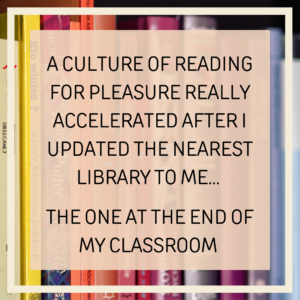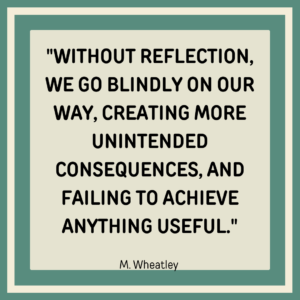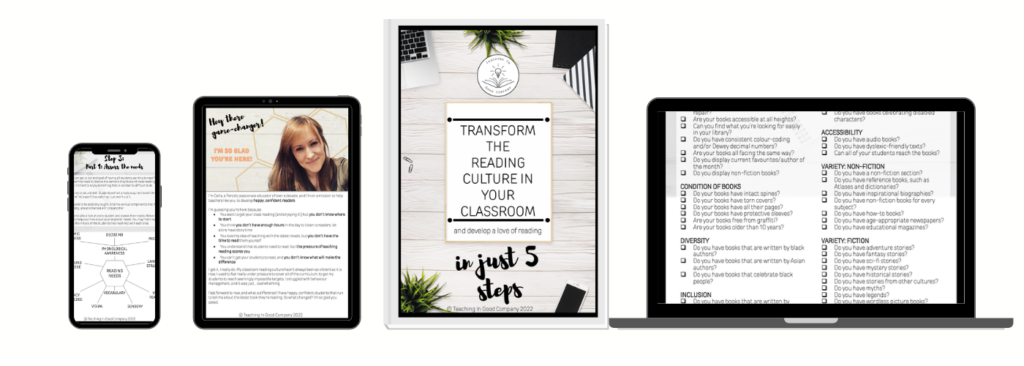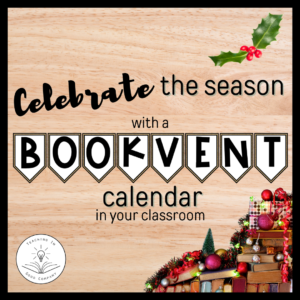This month, I’m starting a new job at a new school and I’m reflecting back on the reading community I built in my last school and how reading for pleasure started in the nearest library to me: the one at the bottom of my classroom!
In my last post, I shared with you an insight into my journey of building a reading community and that pivotal moment when my eyes were really truly opened to the chaos that was my nearest library- yes, that’s right, I’m talking about the library at the end of my classroom! Once my eyes were opened, there was no un-seeing or ignoring it. I had to do something about it.
Here’s a little something you should know about me: once I get a bee in my bonnet about something, that’s it! I’m off! I am just not one of those people who can turn a blind eye to a bad situation. It’s probably why I’m never bored: I always have about half a dozen projects on the go.
Anyway, every day, as I walked through the library and into my classroom something deep inside me niggled. Something needed to be done. And me being me, I decided that I was the person for the job.
Now, with hindsight, of course this would have been much better if this had been a team project. But the reality was that the majority of the school team were
a) not using their nearest library (which given it’s state wasn’t a huge surprise!)
and
b) weren’t having to look at it everyday, so really it wasn’t their number one priority (out of sight, out of mind)
I had never modernised a library before and honestly, I didn’t have a clue what I was doing. So how was I to coordinate a plan for a team to tackle this monstrosity?
Undeterred and without a plan, I got to it. After all, my nearest library was only 5m away and in desperate need of modernisation.
I didn’t know much, but I did know:
> that I needed to know what was on the shelves
> I needed to make what was on the shelves relevant
> and that I really, really needed newer books.
You don’t need me to repeat myself, if you missed my previous blog post you can check it here, but what I did want to share with you were a few of the ways I tried to organise my library, the mistakes I made, the lessons learned and what I’m going to do differently this time around.
HOW I ORGANISED MY CLASS LIBRARY
Once the shelves were cleared, I got to sorting through the books. I wanted to have two clear zones in my library: fiction and non-fiction. Diligently, I separated them into two groups. Easy enough… or so I thought…
HOW I ORGANISED MY NON-FICTION BOOKS
Some of our non-fiction books had previously been classified by the local library service in the Dewey Decimal Classification system- the most popular book organisational system in the world. The Dewey Decimal Classification is used in libraries globally and using it was a skill I wanted to teach my class. If you don’t know about the DDC, it’s a system with 10 main classes, subdivided further into specific topics. Once in place, it’s a really great system as books are placed on the shelves in number order (and great for consolidating Key Stage Two pupils’ understanding of decimal place value!)
I stacked books into loose piles based on the numbers already assigned to them and the ten main DDC categories:
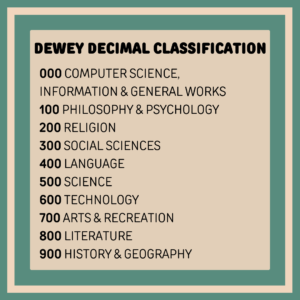
But then came the tough bit- how would I organise the rest of the books?
HOW I ORGANISED MY FICTION BOOKS
Fiction books already existing in the shambles that was our library, had a huge array of different labels. What had once been a clearly marked system of colour-coded genres, had become extremely muddled. Clearly, coloured labels had run out, and library monitors had differing interpretations of the main themes in a book.
Aside from needing to have a clearer system so that books could be found and replaced easily, there was something as a whole Key Stage Two teacher that I wanted to do- help children find age-appropriate books.
Hear me out, whilst I never want children to feel that some books are off-bounds or that they have to have a certain amount of years under their belt before they can enjoy a book, there is a genre where I feel strongly that guidelines help avoid unnecessary scares: the spooky section. There is a HUGE difference in a spooky book for 7 year olds, versus a spooky book for 11 year olds. Likewise, some books, such as The Boy In The Striped Pyjamas, whilst excellent, could cause real distress if in the hands of a young child who picked it up curious about a boy wearing striped pyjamas.
So, I made two lists of things to do: categorise books by age range to help children find age-appropriate books; and to redo the genre classifications.
The former of these tasks, although onerous, was fairly straight forward thanks to the Level It Books app. After making year group stickers, I just scanned the books and assigned each book to a year group, then stuck a label on them and placed them on the numbered shelves. For the books where their ISBNs were not recognised by the app, I used my teacher judgement by scanning the books looking for spelling structures, text size and length, use of literary devices and plot complexity to gauge the approximate lexile level.
When it came to the latter task of organising the books by genre, I had to review the existing classifications and where I could, use the existing colour bands. One thing that really helped with this process came from Chicken House Publishers: above the ISBNs on their books they have “this book in three words”. But even with that, I found it really hard to hone in on just one main theme or genre to classify the books.
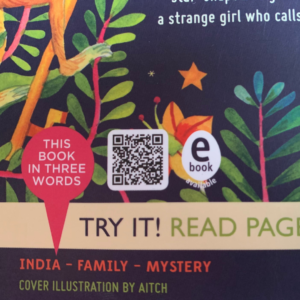
HOW I ORGANISED THE LIBRARY SPACE
THE SPACE BEFORE THE UPDATE
Imagine a long rectangle with a staircase up one of the longer sides- that’s the kind of space I was working with. It would have been so easy to just line the bookshelves up against the wall, leaving a big open space in the middle. And, that’s exactly how we had had the space the year before during the Covid Pandemic where we commandeered the space to turn it into a second classroom (enabling us to separate lower key stage 2 from upper key stage 2, teaching from the middle with a strict timetable to try to keep the year groups as two bubbles with one teacher wherever we could).
But all that happened with that particular layout, minus the rows of desks, was that you ended up with a sparse middle space. It just felt… empty.
THE LIBRARY DESIGN
Aesthetics for the library were really important. I had a clear vision for what I wanted the school library to look like. With the library being in an old Victorian school building, the decor would be crucial in developing the ‘feel’ of the library. I wanted to make the space inviting; like the Gryffindor common room in the Harry Potter films.
I wanted children to feel at home in the library; for it to be cosy, snug and in-keeping with the building.
So, I created two distinct zones: a non-fiction space- almost a complete square of bookshelves, with just a gap to get inside and an inviting big bean bag in the middle. Then a secondary horseshoe of bookshelves, the fiction section, complete with a round table for interventions, group work or just a space for children to use for classwork, reading or playing games.
To make it extra cosy, the antique bookshelves were adorned with warm fairy lights and houseplants were placed up on the window sills. Plans to acquire a couple of wingback armchairs or a nice cosy sofa were never fulfilled because sadly the budget didn’t quite stretch that far.
HOW I PROMOTED READING FOR ENJOYMENT IN MY LIBRARY
I wanted to promote reading books, and I really liked the idea of a Bookflix-type display, but the bold colours would have dominated the space, making it quite oppressive and dark. Instead, I used kraftpaper to keep the display lighter and more muted, and, after downloading the lettering, I made my own slides for each student to showcase their books. It was a hit! A real conversation starter!
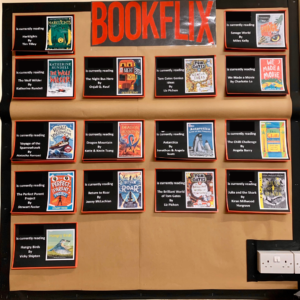
As the children started new books, they asked for their bookflix to be updated, which I did by replacing the details on my powerpoint and once printed, just used a touch of double-sided tape to affix it on top. This meant there was a visual representation of each student’s reading journey that year.
THE IMPACT OF BOOKFLIX
Amazingly, when students were ready for a new book, they used the Bookflix display to help choose a new book and actually started talking to one another about books to find out more to inform their decision. After all those years of trying to coax books into children’s hands, the answer hit me in the face: they honestly didn’t give two hoots what I thought made a great book. Nope. They were interested in what their peers thought about books.
I shouldn’t have been surprised by that, but nevertheless I was.
MISTAKES I MADE WHEN ORGANISING MY CLASS LIBRARY
NON-FICTION
Here’s the difficulty I faced: books in the DDC are ordered by discipline, not subject, meaning some subjects could appear in several disciplines (consider a book on The Amazon- this could feature information on the geography of the Amazon as well as the history and sciences of both the river and rainforest) Oh! And it updates, so there’s that to consider too.
Not being a librarian, or being able to access the Schools Local Library Service, meant I did have a clue how to properly classify these books.
FICTION MISTAKES
Although my class knew that the year group bands on the books were advisory only and not restrictive, they did cause problems, that truth-be-told, I should have seen coming. By giving each book an age range, the message sent out to students was, “Although you don’t have to be this age to read this book, your teacher thinks you should,” and “Oh! You’re reading a book with a label on it that says suitable for students 2 years younger than you? You must be stupid!”
Assigning year groups to a particular list of books IS restrictive, and it can knock the enjoyment out of reading altogether.
WHAT I’M GOING TO DO DIFFERENTLY
Starting a new school presents me with a blank slate… and potentially the same scenario- an old library in need of modernisation. So here are the things I intend to do differently:
> I want to learn more about the Dewey Decimal System to help update and organise existing and new non-fiction books
> I’ll use the search tool in GoodReads to help classify book genres more effectively
> If there are books with sensitive material in them, I’ll discretely mark them with a star. Students will then be able to check with another student or teacher before reading.
> To promote reading for enjoyment, I’ll use more collaborative book displays to celebrate books.
HOW I’M GOING TO START BUILDING A READING COMMUNITY FROM SCRATCH
Will I manage this overnight? Absolutely not. I know that by starting a new school I’m going to have a lot on my plate initially- there’ll be new policies and procedures to learn, a classroom to set-up, a curriculum to plan and students to get to know. After fourteen years of teaching, I know that if I put too much on my plate to start off with, I’ll be headed on a one-way trip to Burnoutsville.
Instead, I plan to set myself small achievable goals that I can build into successful and transformative habits. After all, I did it before and I can do it again. Rome wasn’t built in a day, and neither will my new reading community.
If you’re starting out somewhere new like me, or you want this year to be the year you put reading for pleasure on the map in your school, feel free to come join me on my journey! Every day, I’m sharing my daily goal on Instagram and I would love it if you joined in too.
I hope you have the very best start to term,


